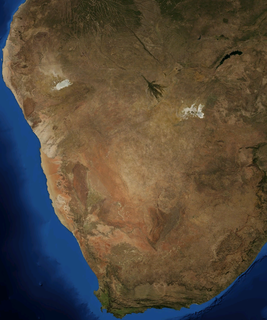
Botswana, officially the Republic of Botswana, is a landlocked country in Southern Africa. Botswana is topographically flat, with up to 70 percent of its territory being the Kalahari Desert. It is bordered by South Africa to the south and southeast, Namibia to the west and north, and Zimbabwe to the northeast. It is connected to Zambia across the short Zambezi River border by the Kazungula Bridge.

The Kalahari Desert is a large semi-arid sandy savannah in Southern Africa extending for 900,000 square kilometres (350,000 sq mi), covering much of Botswana, and parts of Namibia and South Africa.

Survival International is a human rights organisation formed in 1969 that campaigns for the rights of indigenous and/or tribal peoples and uncontacted peoples.

Khoisan, or Khoe-Sān, according to the contemporary Khoekhoegowab orthography, is a catch-all term for those indigenous peoples of Southern Africa who don't speak one of the Bantu languages, combining the Khoekhoen and the Sān or Sākhoen.

The San peoples, or Bushmen, are members of various Khoe, Tuu, or Kxʼa-speaking indigenous hunter-gatherer cultures that are the first cultures of Southern Africa, and whose territories span Botswana, Namibia, Angola, Zambia, Zimbabwe, Lesotho and South Africa. In 2017, Botswana was home to approximately 63,500 San people, which is roughly 2.8% of the country's population, making it the country with the highest population of San people.
Debswana Diamond Company Limited, or simply Debswana, is a mining company located in Botswana, and is the world's leading producer of diamonds by value. Debswana operates four diamond mines in the eastern and central parts of Botswana, as well as a coal mine. Debswana is a joint venture between the government of Botswana and the South African diamond company De Beers; each party owns 50 percent of the company.

Ghanzi is a town in the middle of the Kalahari Desert the western part of the Republic of Botswana in southern Africa. The region is the country's pride in contributing a large portion towards the beef industry. In fact, Ghanzi farmers provides about 75% percent of beef exports, according to the Botswana Meat Commission, primarily to the United Kingdom and the European Union
The International Socialists Botswana (ISBO) is a small Botswanan Trotskyist organisation. It is part of the International Socialist Tendency and produces a newspaper called Socialism from Below.
First People of the Kalahari (FPK) was a local advocacy organisation in Botswana that worked for the rights of the indigenous San who had been forced by the Government of Botswana to resettle to the new built town of New Xade. The organization was founded in 1991, registered in 1992 and officially recognised in 1993. Roy Sesana became chairman in 1995 and had a leading role in the organisation. Sesana and FPK were awarded the Right Livelihood Award in 2005. FPK had dissolved as an organisation by 2013.

Central Kalahari Game Reserve is an extensive national park in the Kalahari Desert of Botswana. Established in 1961 it covers an area of 52,800 square kilometres (20,400 sq mi), making it the second largest game reserve in the world.
John Qace Hardbattle (1945-1996) was one of the best-known Bushman activists in Botswana. "Son of a half-Bushman mother, Khwa, and an English father, Tom Hardbattle",His father a retired policeman who traveled to South Africa and then Botswana. There he married "Kawi", John's mother. John Hardbattle co-founded and became leader of the First People of Kalahari (FPK).

New Xade is a village located in the central part of the Ghanzi District of Botswana. The population was 930 in 2001 census.

Botswana's principal tourist attractions are its game reserves, with hunting and photographic safaris available. Other attractions include the Okavango Delta region, which during the rainy season is a maze of waterways, islands, and lakes. The tourism industry also helped to diversify Botswana's economy from traditional sources such as diamonds and beef and created 23,000 jobs in 2005.

Gem Diamonds is a British-based global diamond mining business. It is headquartered in London and is listed on the London Stock Exchange. In 2017, the company generated a profit of $20.8 million.
Conservation refugees are people who are displaced from their native lands when conservation areas, such as parks and other protected areas, are created.

Stephen Corry is a British indigenous rights activist, better known as the CEO of Survival International. He was asked to lead the organisation in 1984. In 1993 he became the chairman of the Free Tibet Campaign and remains on its board.
The 2011 Botswana Population and Housing Census was the latest national census of Botswana. The enumeration was managed by the Central Statistics Office and took place over ten days starting on 22 August 2011. The census counted a total population of 2,024,787, a 20.5% increase from the 2001 Census.
The following lists events that happened during 2006 in Botswana.
Ancestral land conflict over the Central Kalahari Game Reserve (CKGR) arose in the 1970s between the government of Botswana and the San people (Bushmen), and is ongoing, resulting in one of the most expensive court cases in the history of Botswana.
James Suzman is an anthropologist and the author of Affluence Without Abundance: The disappearing world of the Bushmen published by Bloomsbury in 2017. He is the nephew of Janet Suzman and great-nephew of Helen Suzman. He is based in Cambridge, UK.









